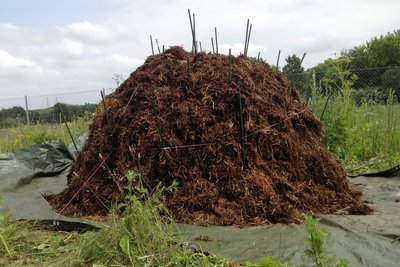Parasitic worms – a challenge in organic pig production
Organic pigs have more intestinal parasites than conventional pigs. Yet, the contamination with parasite eggs and can be reduced by management procedures, the research project PAROL concludes.

By Helena Mejer, Tove Serup and Stig Milan Thamsborg
The research project PAROL (Organic RDD) has examined the occurrence of parasites in starter pigs (12-16 weeks), fattening pigs (22-26 weeks) and sows on five organic herds. Three intestinal parasitic worms were detected; the large round worm (main focus of the project), the nodular worm and the whip worm. Environmental contamination was mapped and potential control measures examined.
Pastures
Piglets on all farms were exposed to the large round worm eggs on the farrowing pastures. Most farms had semi-permanent pastures. Rotation schemes of 1-3 years being too short to allow for natural mortality to ensure "clean" pastures. Especially paddocks for weaned and fattening pigs should be considered a hazard. This is due to the high prevalences, egg excretion rates and stocking rates in these age groups. One study at the university farm indicated that maximum pasture infectivity is reached 2-3 years after contamination. Ploughing of the pastures did not seem to be able to reduce infection levels in pigs.
Apart from long-term (e.g. min 5 years) rotation schemes, there are currently no ways to sufficiently inactivate eggs in the soil. In highly infected herds it may be necessary to treat pigs when they are moved to the stable.
Stables
Only a very small proportion of the large round worm eggs in the bedding material were infective to pigs. Still, as there were millions of eggs, enough were infective for the pigs to be continuously exposed. So much so that 87% of the fatteners was positive for liver white spots (due to migrating larvae) at the abattoir. Bedding material may help parasite eggs to survive, but the amount of litter appeared to be less important. The project could not confirm previous suggestion that deep litter deep litter is particularly problematic.
Parasite eggs were found not just on the pen floor, but also on walls and inventory. The results also indicated that sprinklers placed close to areas with straw and manure may dilute urine and faeces. This may reduce the negative impact of ammonia and improve egg survival and development.
Lack of cleaning between batches of pigs was identified as a risk factor. Ideally all manure and straw should be removed and pens washed 1-2 times a year. The pens should then be allowed to dry out, preferably using a gas burner, as heat kills the eggs. Even small amounts of faeces and straw severely reduced the effect of disinfectants.

Experimental manure heaps to study the effect of composting on large round worm eggs.
Composting
For all five farms it was estimated that 81 % of the eggs were dead due to unfavourable conditions (high ammonia, high temperature and/or low humidity) in the litter. The remaining eggs were still viable and millions of eggs could potentially develop if ploughed into the soil with the manure.
The project therefore examined composting of straw with solid manure. The outcome was that if the material is too hot touch (70oC) the eggs will be dead. Alternatively, composting at 50oC for up to one week will also kill the eggs. At 25oC, slurry should be stored for one year, but at lower temperatures this is not enough to inactivate all the eggs.